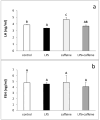Effect of Caffeine on the Inflammatory-Dependent Changes in the GnRH/LH Secretion in a Female Sheep Model
- PMID: 38473910
- PMCID: PMC10932312
- DOI: 10.3390/ijms25052663
Effect of Caffeine on the Inflammatory-Dependent Changes in the GnRH/LH Secretion in a Female Sheep Model
Abstract
Caffeine is one of the most widely consumed psychoactive drugs in the world. It easily crosses the blood-brain barrier, and caffeine-interacting adenosine and ryanodine receptors are distributed in various areas of the brain, including the hypothalamus and pituitary. Caffeine intake may have an impact on reproductive and immune function. Therefore, in the present study performed on the ewe model, we decided to investigate the effect of peripheral administration of caffeine (30 mg/kg) on the secretory activity of the hypothalamic-pituitary unit which regulates the reproductive function in females during both a physiological state and an immune/inflammatory challenge induced by lipopolysaccharide (LPS; 400 ng/kg) injection. It was found that caffeine stimulated (p < 0.01) the biosynthesis of gonadotropin-releasing hormone (GnRH) in the hypothalamus of ewe under both physiological and inflammatory conditions. Caffeine also increased (p < 0.05) luteinizing hormone (LH) secretion in ewes in a physiological state; however, a single administration of caffeine failed to completely release the LH secretion from the inhibitory influence of inflammation. This could result from the decreased expression of GnRHR in the pituitary and it may also be associated with the changes in the concentration of neurotransmitters in the median eminence (ME) where GnRH neuron terminals are located. Caffeine and LPS increased (p < 0.05) dopamine in the ME which may explain the inhibition of GnRH release. Caffeine treatment also increased (p < 0.01) cortisol release, and this stimulatory effect was particularly evident in sheep under immunological stress. Our studies suggest that caffeine affects the secretory activity of the hypothalamic-pituitary unit, although its effect appears to be partially dependent on the animal's immune status.
Keywords: GnRH; caffeine; hypothalamus; inflammation; luteinizing hormone; pituitary.
Conflict of interest statement
The authors declare no conflicts of interest.
Figures




Similar articles
-
Effect of endotoxin on the expression of GnRH and GnRHR genes in the hypothalamus and anterior pituitary gland of anestrous ewes.Anim Reprod Sci. 2010 Jul;120(1-4):105-11. doi: 10.1016/j.anireprosci.2010.03.011. Epub 2010 Apr 8. Anim Reprod Sci. 2010. PMID: 20427135 Clinical Trial.
-
Effect of short-term and prolonged stress on the biosynthesis of gonadotropin-releasing hormone (GnRH) and GnRH receptor (GnRHR) in the hypothalamus and GnRHR in the pituitary of ewes during various physiological states.Anim Reprod Sci. 2016 Nov;174:65-72. doi: 10.1016/j.anireprosci.2016.09.006. Epub 2016 Sep 8. Anim Reprod Sci. 2016. PMID: 27629353
-
Caffeine stimulates in vitro pituitary LH secretion in lipopolysaccharide-treated ewes.Reprod Biol. 2015 Mar;15(1):20-6. doi: 10.1016/j.repbio.2014.12.001. Epub 2014 Dec 15. Reprod Biol. 2015. PMID: 25726373 Clinical Trial.
-
The impact of inflammatory stress on hypothalamic kisspeptin neurons: Mechanisms underlying inflammation-associated infertility in humans and domestic animals.Peptides. 2023 Apr;162:170958. doi: 10.1016/j.peptides.2023.170958. Epub 2023 Jan 20. Peptides. 2023. PMID: 36682622 Review.
-
Neurophysiological control of the secretion of gonadotrophin-releasing hormone and luteinizing hormone in the sheep--a review.Reprod Fertil Dev. 1991;3(2):137-73. doi: 10.1071/rd9910137. Reprod Fertil Dev. 1991. PMID: 1947218 Review.
References
-
- Herman A.P., Krawczyńska A., Bochenek J., Haziak K., Romanowicz K., Misztal T., Antushevich H., Herman A., Tomaszewska-Zaremba D. The effect of rivastigmine on the LPS-induced suppression of GnRH/LH secretion during the follicular phase of the estrous cycle in ewes. Anim. Reprod. Sci. 2013;138:203–212. doi: 10.1016/j.anireprosci.2013.03.005. - DOI - PubMed
MeSH terms
Substances
Grants and funding
LinkOut - more resources
Full Text Sources
Medical

